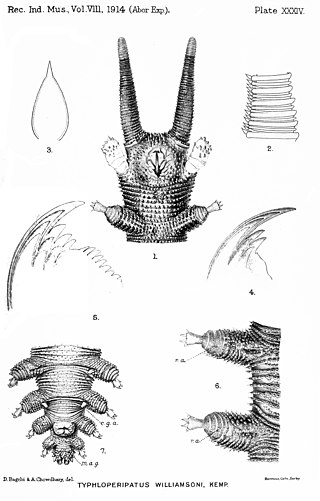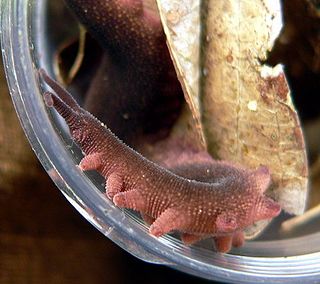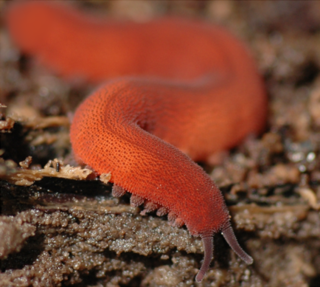
Onychophora, commonly known as velvet worms or more ambiguously as peripatus, is a phylum of elongate, soft-bodied, many-legged animals. In appearance they have variously been compared to worms with legs, caterpillars, and slugs. They prey upon other invertebrates, which they catch by ejecting an adhesive slime. Approximately 200 species of velvet worms have been described, although the true number of species is likely greater. The two extant families of velvet worms are Peripatidae and Peripatopsidae. They show a peculiar distribution, with the peripatids being predominantly equatorial and tropical, while the peripatopsids are all found south of the equator. It is the only phylum within Animalia that is wholly endemic to terrestrial environments, at least among extant members. Velvet worms are generally considered close relatives of the Arthropoda and Tardigrada, with which they form the proposed taxon Panarthropoda. This makes them of palaeontological interest, as they can help reconstruct the ancestral arthropod. Only two fossil species are confidently assigned as onychophorans: Antennipatus from the Late Carboniferous, and Cretoperipatus from the Late Cretaceous, the latter belonging to Peripatidae. In modern zoology, they are particularly renowned for their curious mating behaviours and the bearing of live young in some species.

Peripatus is a genus of velvet worms in the Peripatidae family. The name "peripatus" is also used to refer to the Onychophora as a whole, although this group comprises many other genera besides Peripatus. The genus Peripatus is found in Central America, the Caribbean and northern South America. This genus is viviparous, with mothers supplying nourishment to their embryos through a placenta.
Macroperipatus is a genus of Neotropical velvet worms in the Peripatidae family. Velvet worms in this genus can have as few as 24 pairs of legs or as many as 42 leg pairs. This genus is viviparous, with mothers supplying nourishment to their embryos through a placenta.
Mesoperipatus is a monospecific genus of velvet worm in the Peripatidae family, containing a single species Mesoperipatus tholloni. It is found in Gabon, making it the only known species of velvet worm in the tropics of Africa, and the only known species of peripatid velvet worm in Africa. Females of this species have 24 to 27 pairs of legs; males have 23 or 24. This species is viviparous, but too little is known of its embryology to describe its reproductive mode in any more detail; the presence of a placenta, for example, has not been confirmed.

Typhloperipatus is a genus of velvet worm in the family Peripatidae, containing the sole species Typhloperipatus williamsoni. This genus contains the only species in the phylum Onychophora found in South Asia. This species is also striking in that this velvet worm shows no external trace of eyes, although rudimentary optical vesicles are present internally. This species is also notable for featuring males with the minimum number of legs recorded in any velvet worm in the family Peripatidae.

Peripatidae is a family of velvet worms. This family includes more than 90 described species distributed among 13 genera, but some authorities deem only 80 of these species to be valid. The oldest putative representatives of the family herald from Burmese amber dated to the mid-Cretaceous, around 100 million years ago, with representatives from Dominican and Baltic amber attesting to a broader distribution in the Palaeogene / Neogene; molecular variability suggests that the family's crown group may have arisen in the early Mesozoic.

Eoperipatus is a genus of velvet worms in the family Peripatidae. These velvet worms have been reported from locations throughout Southeast Asia, including Malaysia, Singapore, Thailand, and Vietnam. This genus exhibits lecithotrophic ovoviviparity; that is, mothers in this genus retain yolky eggs in their uteri.

Epiperipatus is the most diverse genus of neotropical velvet worms in the family Peripatidae. Species in this genus are found in Central and South America. This genus is viviparous, with mothers supplying nourishment to their embryos through a placenta.

Oroperipatus is a genus of Neotropical velvet worms in the family Peripatidae. Species in this genus are found in South America west of the Andes and in Mexico. This genus is viviparous, with mothers supplying nourishment to their embryos through a placenta.

Eoperipatus totoro is a species of velvet worm of the family Peripatidae. This species is notable as the first velvet worm from Vietnam to be formally described. As of 2023, E. totoro remains the only species of velvet worm from Vietnam to be described.
Cerradopatus is a monospecific genus of velvet worm containing the single species Cerradopatus sucuriuensis. Males of this species have 28 or 29 pairs of legs; females have 30 to 32. This species is native to the Brazilian savannah. This species is viviparous, with mothers supplying nourishment to their embryos through a placenta.
Paropisthopatus is a monospecific genus of velvet worm containing the single species Paropisthopatus umbrinus. Females of this species range from 20 mm to 70 mm in length. The type locality is in central Chile. Velvet worms in this genus have 16 pairs of legs. This genus exhibits matrotrophic viviparity, that is, mothers in this genus retain eggs in their uteri and supply nourishment to their embryos, but without any placenta.
Paraperipatus is a genus of velvet worms in the family Peripatopsidae. This genus exhibits matrotrophic viviparity, that is, mothers in this genus retain eggs in their uteri and supply nourishment to their embryos, but without any placenta. Species in this genus are found in New Guinea and the surrounding islands, including the Maluku achipelago.
Eoperipatus horsti is a species of velvet worm in the Peripatidae family. Authorities have designated this velvet worm as the type species for the genus Eoperipatus, because among the species originally included in this genus, this species is the only one known from descriptions of both sexes. This species is found in Malaysia.
Epiperipatus acacioi is a species of velvet worm in the Peripatidae family. This species is dark purple with a bilaterally symmetric pattern on its dorsal surface and ranges from 13 mm to 47 mm in length. Males of this species have 24 to 27 pairs of legs, usually 25 or 26; females have 26 to 30, usually 27 or 28. The type locality is in Minas Gerais, Brazil.
Epiperipatus simoni is a species of velvet worm in the Peripatidae family. This species is dark brown without any pattern on its dorsal surface. Females of this species range from 40 mm to 68 mm in length and have 28 to 32 pairs of legs. The type locality is in Venezuela.
Epiperipatus evansi is a species of velvet worm in the Peripatidae family. This species is a purplish dark brown with a series of bright triangles on each side forming a series of diamonds down its back. Females of this species have 28 pairs of legs and range from 32 mm to 58 mm in length. The type locality is in Guyana.
Epiperipatus hilkae is a species of velvet worm in the Peripatidae family. This species is found in Costa Rica. This velvet worm is closely related to another species of Epiperipatus found in Costa Rica, E. isthmicola. The species E. hilkae is named in honor of the German zoologist Hilke Ruhberg for her extensive work on velvet worms.
Mongeperipatus solorzanoi, also known as Solórzano's velvet worm, is a species of velvet worm in the family Peripatidae. This species is the largest known velvet worm, reaching 22 cm in length. This velvet worm is found in the Caribbean coastal forest of Costa Rica.
Mongeperipatus is a genus of velvet worms in the family Peripatidae from Costa Rica. The biologists José Pablo Barquero-González, Steven Sánchez-Vargas, and Bernal Morera-Brenes introduced this genus in 2020 to contain the newly discovered type species, M. kekoldi, together with another species, M. solorzanoi. A phylogenetic analysis using DNA sequences placed these two species in their own monophyletic clade. Furthermore, these two species share morphological characters that indicate that these species do not belong in the other genera and instead belong together in a separate genus. The genus Mongeperipatus is named in honor of the Costa Rican biologist Julián Monge-Nájera.







